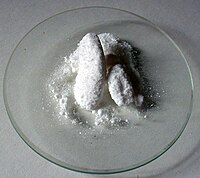Sodium tungstate
 |
|
| Names | |
|---|---|
|
IUPAC name
Sodium tungstate
|
|
| Identifiers | |
|
3D model (Jmol)
|
|
| ECHA InfoCard | 100.033.389 |
|
PubChem CID
|
|
| RTECS number | YO7875000 |
|
|
|
|
| Properties | |
| Na2O4W | |
| Molar mass | 293.82 g·mol−1 |
| Appearance | white rhombohedral crystals |
| Density | 4.179 g/cm3 (anhydrous) 3.25 g/cm3 (dihydrate) |
| Melting point | 698 °C (1,288 °F; 971 K) |
| 57.5 g/100 mL (0 °C) 74.2 g/100 mL (25 °C) 96.9 g/100 mL (100 °C) |
|
| Solubility | slightly soluble in ammonia insoluble in alcohol, acid |
| Structure | |
| rhombic (anhydrous) orthorhombic (dihydrate) |
|
| Hazards | |
| Safety data sheet | External MSDS |
|
Except where otherwise noted, data are given for materials in their standard state (at 25 °C [77 °F], 100 kPa).
|
|
|
|
|
| Infobox references | |
Sodium tungstate is the inorganic compound with the formula Na2WO4. This white, water-soluble solid is the sodium salt of tungstic acid. It is useful as a source of tungsten for chemical synthesis. It is an intermediate in the conversion of tungsten ores to the metal.
The predominant route to this salt is the extraction of tungsten ores, almost all of which are tungstates. Thus, the ores are treated with a base to give sodium tungstate, as illustrated in the case of wolframite:
Scheelite is treated similarly using sodium carbonate.
Sodium tungstate can also be produced by treating tungsten carbide with a mixture of sodium nitrate and sodium hydroxide in a fusion process which overcomes the high exothermicity of the reaction involved.
Several polymorphs of sodium tungstate are known, three at only one atmosphere pressure. They feature tetrahedral orthotungstate dianions but differ in the packing motif. The WO42− anion adopts a structure like sulfate (SO42−).
Treatment of sodium tungstate with hydrochloric acid gives the trioxide:
This reaction can be reversed using aqueous solution of sodium hydroxide
In organic chemistry, sodium tungstate is used as catalyst for epoxidation of alkenes and oxidation of alcohols into aldehydes or ketones.
It is also known for its anti-diabetic effects; researchers have identified the pathways through which sodium tungstate improves pancreatic function and beta cell proliferation.
...
Wikipedia
